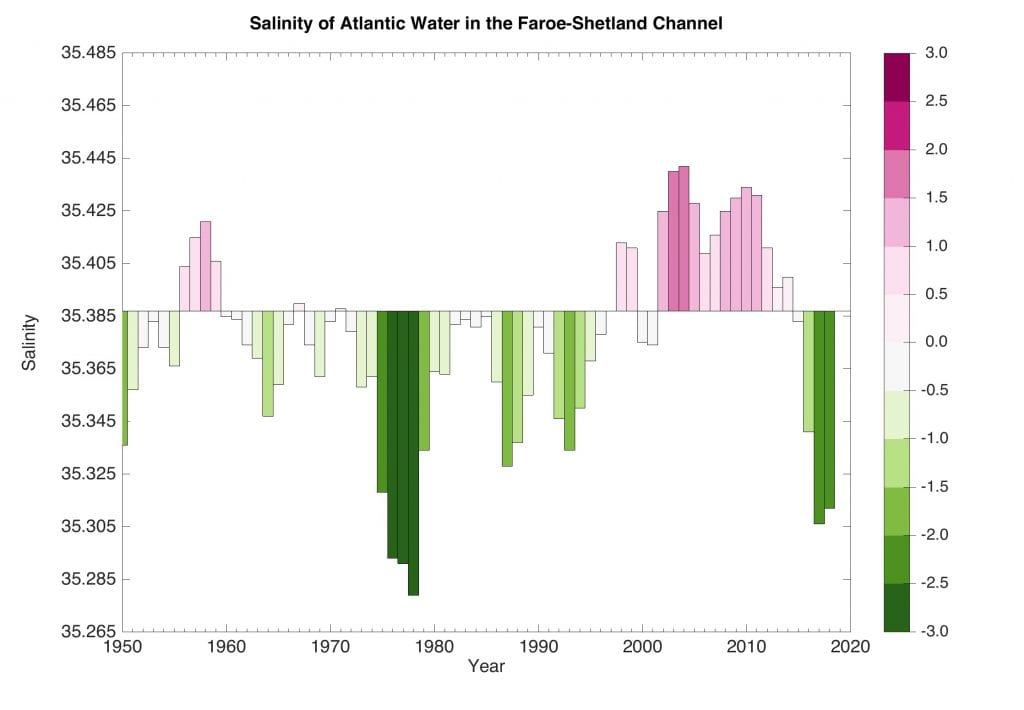Marine
Recent Decrease in Ocean Salinity in the North Atlantic Waters off Scotland
January 31, 2020 by Marine Directorate Communications 2 Comments | Category Collaborations, Marine Directorate general, Marine Directorate Science, Oceanography, Publications
Research published in Nature Communications this week has investigated the recent, large reduction in salinity measurements in the North Atlantic Ocean. Evidence of this surface salinity change includes the time series collected by Marine Scotland Science in the Faroe-Shetland Channel.
Scientists observed the freshening event over a large region of the North Atlantic, extending from waters to the west of the UK to Iceland in 2016. For some of the observational time series, the measured salinities were the lowest since records began in the late 19th century. In the Faroe-Shetland Channel, lower salinities were observed during the Great Salinity Anomaly in the 1970s, which was caused by increased freshwater transport through Fram Strait (the passage between Greenland and Svalbard) and winds driving increased freshwater transport from the Greenland shelves.

Observed salinities in the North Atlantic Water in the Faroe-Shetland Channel, collected by Marine Scotland Science. The colour of the bars corresponds to the standardised anomaly relative to the 1981-2010 average (as mean) and standard deviation. The observed salinity is plotted as a bar from the 1981-2010 average salinity (35.387).
The recent salinity change has a different mechanism and was caused by abnormal wind patterns driving Arctic freshwater from the Labrador Current (close to the Canadian continental shelf) into the North Atlantic Current. This current transports waters from the North American region of the Atlantic Ocean towards the UK coast. It is an important influence on environmental conditions in the waters off the Scottish West Coast. This work shows that understanding changes in the circulation further westward in the subpolar North Atlantic provide important context for conditions in our region.
The Great Salinity Anomaly of the 1970s impacted the ecosystem productivity in our region. Some of the authors of this study are currently considering the impact of this recent freshening event on the biological productivity.
Caption for Main Feature Image: Map showing the average surface circulation in the North Atlantic Ocean, arrows show surface current vectors (coloured by strength). The schematic representation of the major currents is overlain in red (in deep water) and yellow (continental shelf). North Atlantic Current (NAC), East Reykjanes Ridge Current (ERRC) East Greenland Current (EGC), West Greenland Current (WGC), Labrador Current (LC) and Mann Eddy (ME). From Holliday et al., 2020.
Further Information
- Holliday, N.P., Bersch, M., Berx, B. et al. Ocean circulation causes the largest freshening event for 120 years in eastern subpolar North Atlantic. Nature Communications 11, 585 (2020).
- NOC News – Changes in ocean circulation cause largest freshening event in NE Atlantic in 120 years
- The Scottish Ocean Climate Status Report
- The ICES Report on Ocean Climate
Tags: Atlantic Ocean, Canadian continental shelf, Faroe-Shetland Channel, ICES, International Council for the Exploration of the Sea, National Oceanography Centre, North Atlantic, ocean circulation, Ocean Salinity, Scottish Ocean Climate Status Report



why does the salinity change has a different mechanism and was caused by abnormal
The low salinity event observed in 2012-2016 was caused by unusual wind patterns in the atmosphere, driving changes in the ocean circulation. These ocean circulation changes included a slowing of the North Atlantic Current (the extension of the Gulf Stream across the North Atlantic Ocean beyond Cape Hatteras, USA) and a diversion of the currents transporting Arctic freshwater away from the land boundary in the west, and into the adjacent deeper sea basins. The previous extreme freshening event, also known as the Great Salinity Anomaly, occurred in the late 1960s. This event had a different cause: increased rain fall and freshwater run off in the Arctic region.